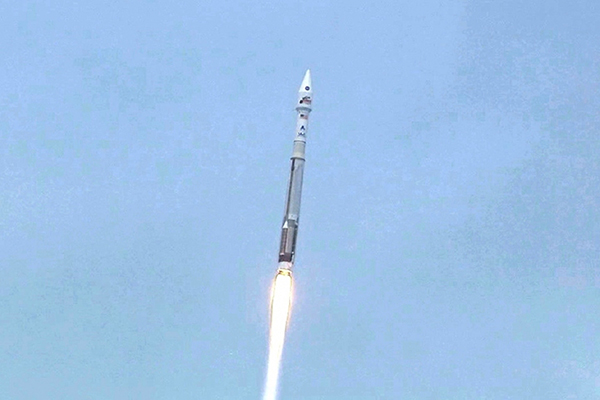
by Sam Lemonick Monday, November 18, 2013

MAVEN launched on Nov. 18 from Cape Canaveral, Fla., aboard a United Launch Alliance Atlas V rocket. NASA
NASA’s latest Mars mission, the Mars Atmosphere and Volatile Evolution (MAVEN) orbiter, successfully blasted off toward the Red Planet today to study how its evolving atmosphere contributed to climate change on Earth's neighbor.
Scientists think water once flowed on Mars' arid and dusty surface, but today, liquid water can’t exist there, partially because of its very thin atmosphere. Atmospheric pressure at Mars’ surface is just 0.6 percent of the pressure felt on Earth’s surface; liquid water boils rapidly at such low pressure. Mars also lacks a global magnetic field like the one that shields Earth’s atmosphere against the solar wind — the charged particles that stream away from the sun.
MAVEN will circle Mars and dip in and out of the planet’s upper atmosphere to study the slow loss of gases into space. NASA’s first orbiter dedicated to studying Mars’ atmosphere will make careful measurements of its composition at different altitudes, and will study Mars’ local magnetic fields and the energetic solar particles that blast atmospheric atoms and molecules into space.
Scientists think Mars lost most of its atmosphere early in its 4.5-billion-year history, when its global magnetic field collapsed and the sun’s energy was stronger. By measuring the small losses to space that are still occurring, scientists intend to use the MAVEN mission to learn more about how the planet’s climate changed.
“At its core, this is an astrobiology mission,” said planetary scientist Bruce Jakosky at a press conference Sunday. Jakosky, MAVEN’s principal investigator, said figuring out how the atmosphere changed and when could help answer questions about whether life could or did exist on Mars. Physicist Janet Luhmann, MAVEN's deputy principal investigator, explained that by measuring what goes in and out from Mars' atmosphere now, scientists may better be able to determine what gases were present in Mars' early atmosphere and if they existed in the right ratios to support life.
MAVEN will follow an elliptical orbit around Mars, 6,000 kilometers above the surface at its farthest point and 150 kilometers at its closest, with a few deep dives to 125 kilometers that will let the orbiter sample the entire upper atmosphere.
Three instruments on an articulated boom can be oriented independently of the solar panels to get the best possible measurements of the atmosphere’s composition as MAVEN descends through it and to get larger-scale data at the craft’s apogee, when it is farthest from the planet. Instruments will also keep track of particles entering and leaving the upper atmosphere, and measure the localized magnetic fields that dot Mars’ surface and interact with the solar wind.
MAVEN is scheduled for one year of sampling, but carries enough excess fuel that it may be able to operate for a decade, Jakosky said.
© 2008-2021. All rights reserved. Any copying, redistribution or retransmission of any of the contents of this service without the expressed written permission of the American Geosciences Institute is expressly prohibited. Click here for all copyright requests.